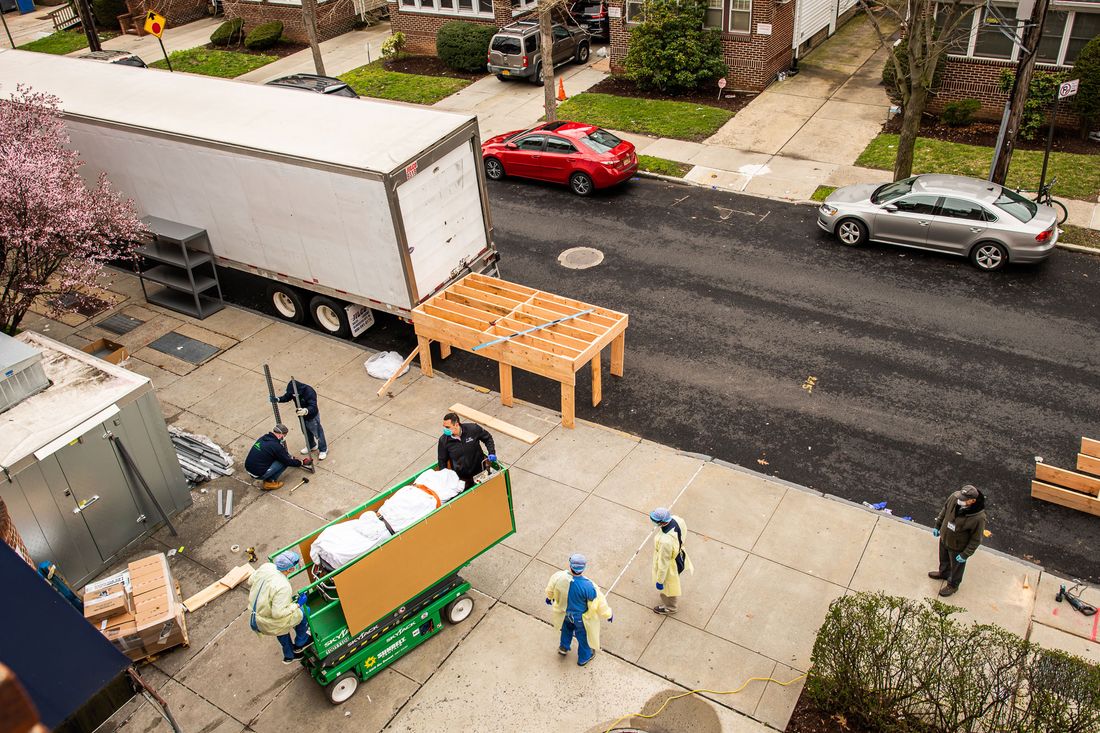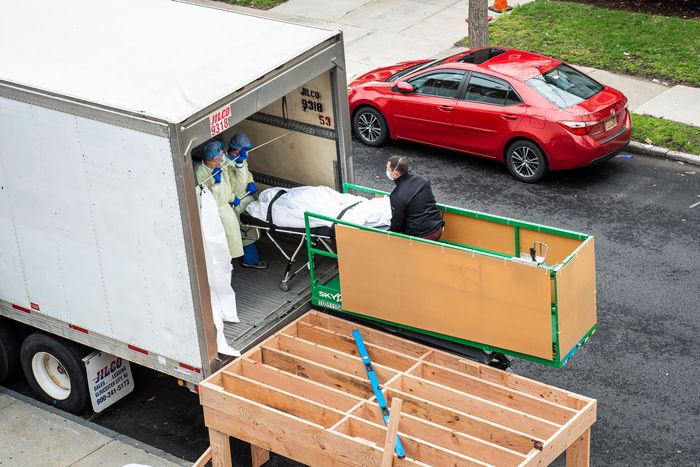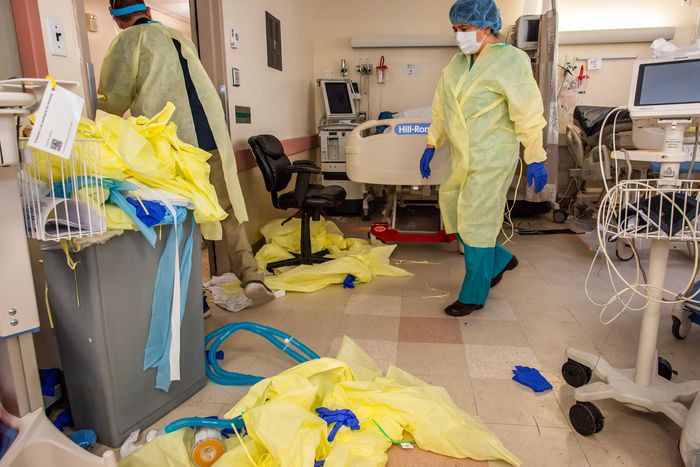
As the COVID-19 crisis continues to unfold, the medical staff at Mount Sinai Brooklyn is providing regular dispatches about their daily experience fighting the virus. Our first interview last Thursday was with chief medical officer Peter Shearer, who said at the time, “To think that somehow it’s going to get worse is hard to imagine.” A week later, we talked to Shearer again. Now, he says, the unimaginable has become “a new normal.” The mobile morgue truck parked outside his window, which had just arrived last week, now holds around 40 bodies, and Shearer and his staff are seeing an average of ten patients a day succumb to COVID-19 complications. At the same time, Shearer says the arrival of new staff has helped, and they are feeling more prepared to tackle the crisis. Here, Shearer’s account of how things have changed in the past week.
It was a really sudden ramp-up with increasing numbers of patients. They were sick and getting admitted, and the beds were filling up, and patients were crashing on the floor. There was a huge adjustment period. It happened very quickly. And while that has not changed, our ability to cope with it has slightly improved. An advantage for me is being a part of the Mount Sinai health system that has a lot of resources, which can be somewhat redeployed. So I’ve had extra doctors sent over, which has been tremendously helpful, though it takes a little bit of time to get everyone into the right place.
For example, there are a lot of outpatient surgical sites in the system that use CRNAs, nurse anesthetists, who right now aren’t doing procedures. They have skills like anesthesiologists, part of which is managing a ventilator.
At the same time as I was getting a bunch of these people referred here,
I was having my highly skilled respiratory therapists drop like flies with COVID-19. It’s a bit of a challenge to make sure that the new people could fill this role, and find a process to put them in place.
But the patients are still here and they’re incredibly sick and they decompensate [organ or system failure resulting in an urgent change in vital signs] rapidly from a respiratory standpoint. My number of ventilators in use has been climbing. I think today might have been one of the first days it has stabilized. When we spoke a week ago, it was around 30 in use, and it peaked at around 50, and now we’re at around 40. But that’s a combination of things. Because some of the people who were on ventilators died.
One new resource I’ve gotten is that we have a lot more palliative-care positions here, and they’re having conversations with patients’ families earlier in the process to really explain what’s going on with their loved ones. Nobody had time before because last week things were so crazy and going so fast. No one really had time to pause for a moment to talk to the family about whether ventilation was actually going to be a helpful thing that anyone would want. Now we are so much better at having a conversation with family about what we know about the disease and what they can expect for the next 24 hours and what the prognosis is, and patients are making more decisions like, “Please just make my grandmother comfortable. She would never want to be on a ventilator for a long period.” We’re actually doing much better that way.
Normally, the families are at the bedside so it’s very easy to have these conversations. Now you’re doing it over the phone, and the family members can feel a little paralyzed. They don’t know what decision to make because they can’t see their loved ones. But now we’re putting iPads in the room so the families can have a Zoom visit with their loved ones, and it makes all the difference in the world.
Nonetheless, let me pull up my mortality report from yesterday, because I haven’t seen it yet. [Pause.] So ten people died yesterday. When we last spoke, it was three or four a day. I’d say ten is probably average now — there have been days that have been better and days that have been much, much worse.
For the nursing staff taking care of these patients, it’s incredibly frustrating because these are people who you’d want to make better. Even for the transport workers who are taking the bodies out to our morgue truck, I think this has become a regular part of their day now. They’re the transport people who normally take people around the hospital, to take them for X-rays and ultrasounds. I’m actually gonna be meeting with them later today to say “Thank you.”
Yesterday was also a good day because we were able to transfer some patients out to the Samaritan’s Purse tents, the 68-bed tent hospital that was put up in Central Park. I was able to transfer one patient yesterday, and I was hoping to transfer another one this morning to the USNS Comfort. The idea is that, for patients who don’t have the coronavirus, we could get them into a non-coronavirus setting. This is helping me manage the intensity of volume in my hospital, though we are still at 100 percent capacity. The chaos seems a little bit more controlled at the moment.
We started putting bodies in the morgue truck last week. And it’s been used a lot. A lot. I think there’s around 40 bodies in there now. The funeral homes are having trouble keeping up a bit. So it’s not like ten people died and people go off to the funeral home. We’re accumulating a certain number of bodies here. We have outfitted it with shelves because you have to keep track of people. You have to make sure that the right family gets the right body back. And you also want to treat these people with respect and dignity knowing that it’s a very unnatural situation.
From my perspective, I feel like I’ve seen the doctors go from being overwhelmed to getting a little bit more of a sense that this is the new normal — for a week, weeks, a month or two … unclear. But they are settling into how they are going to manage this chaos.
I recently had a conversation with one of our pulmonologists, who is also a primary-care physician. He had a patient who was in the hospital whom he had known for more than 20 years. I really felt like I was consoling someone whose good friend had been dying. This is a guy whose eyes usually twinkle when he smiles, and there was none of that. He was just so dulled. These are good doctors who care about their patients and have good relationships with them, and when they feel helpless, it really takes an impact.
I did have another one of my doctors call and speak to a psychiatrist just so that I could feel comfortable that they had an outside set of mental-health eyes and ears, because I could see the burden this was taking on him. He wants to save every life, and when people are just dying on you, that’s defeating.
I have my moments of feeling overwhelmed as well, but I’m fortunate that I’m connected to the Mount Sinai system. I think there are small hospitals out there that aren’t as connected with resources, and I think they’re probably struggling even more.
We’re committed to keeping our readers informed.
We’ve removed our paywall from essential coronavirus news stories. Become a subscriber to support our journalists. Subscribe now.
More From This Series
- Eric Adams’s Plan to Commit the Homeless Has Little Meaning in the ER
- Working Wave After Wave at Elmhurst Hospital
- How One Brooklyn Hospital Survived Its Deadliest Spring
- Diary of a Hospital: ‘It Felt Like a Calling’
- Diary of a Hospital: A Nurse’s Worst Day





































